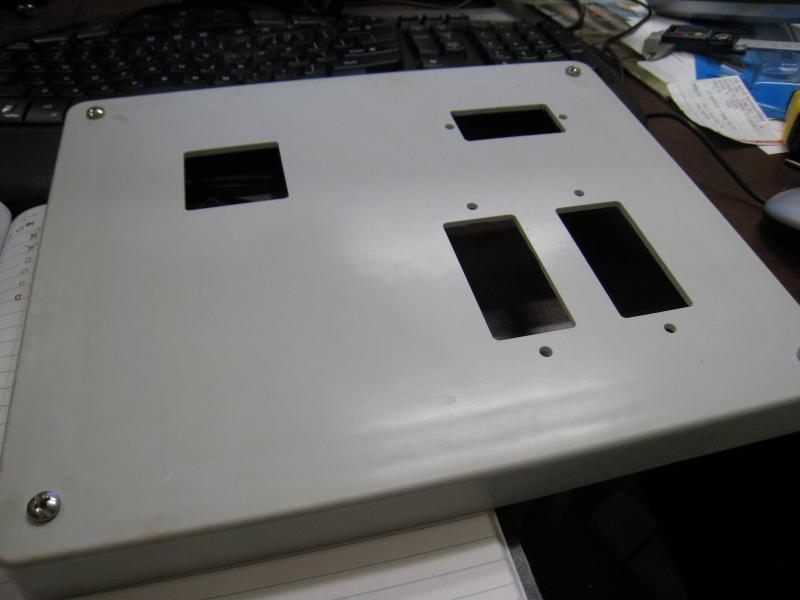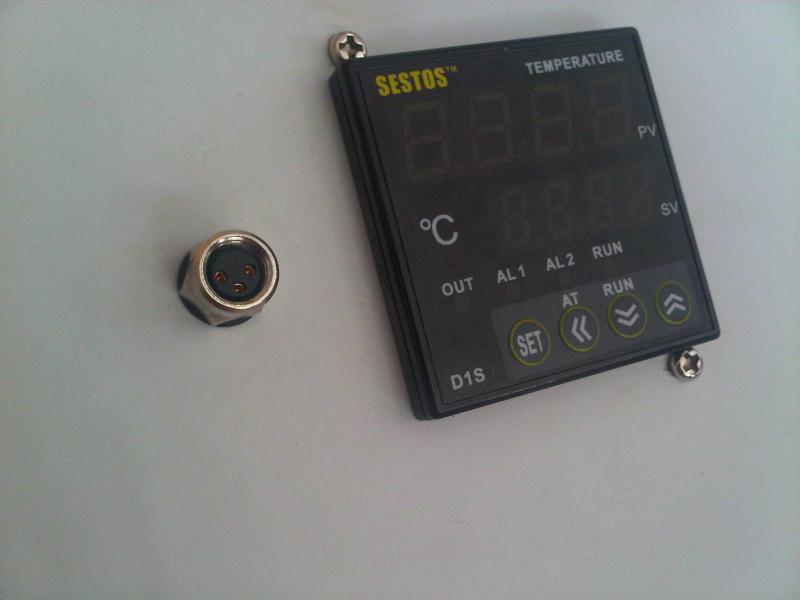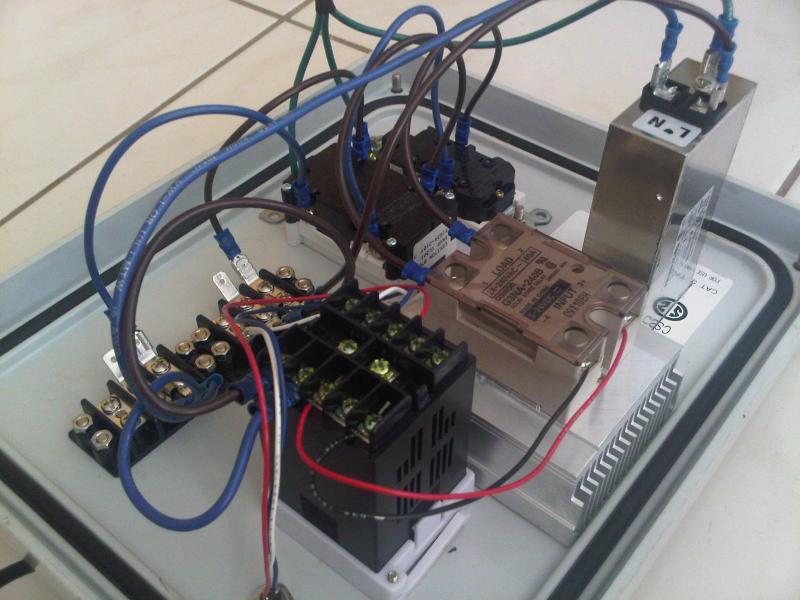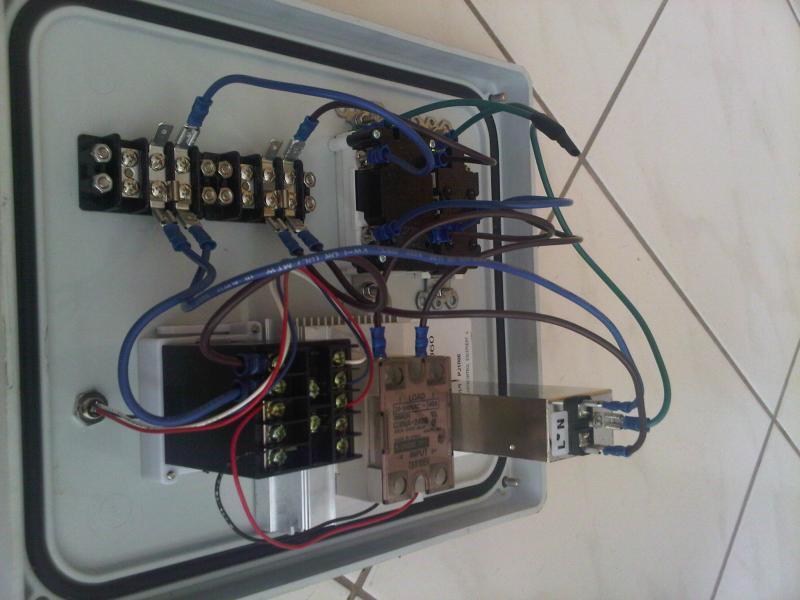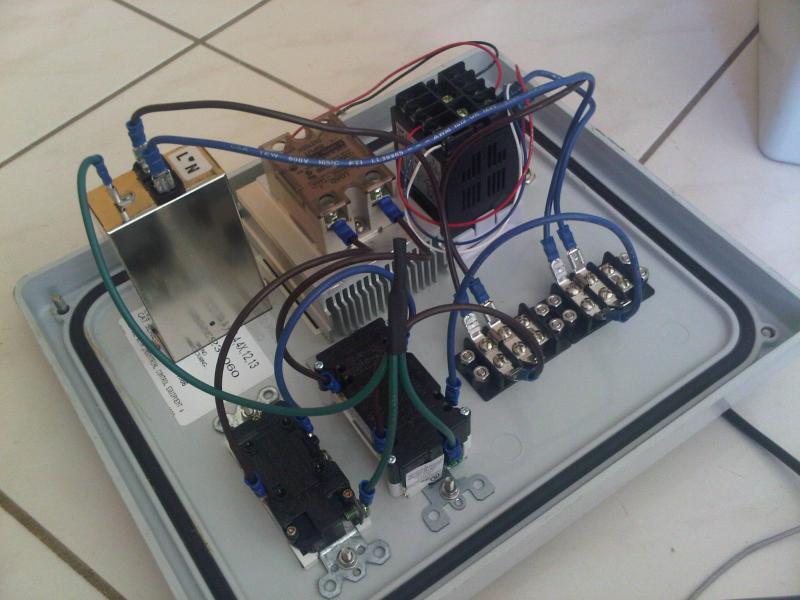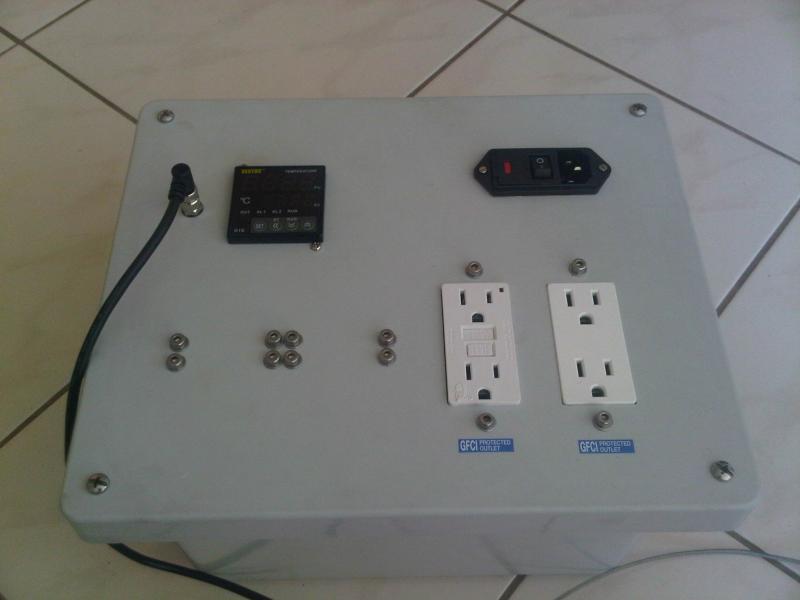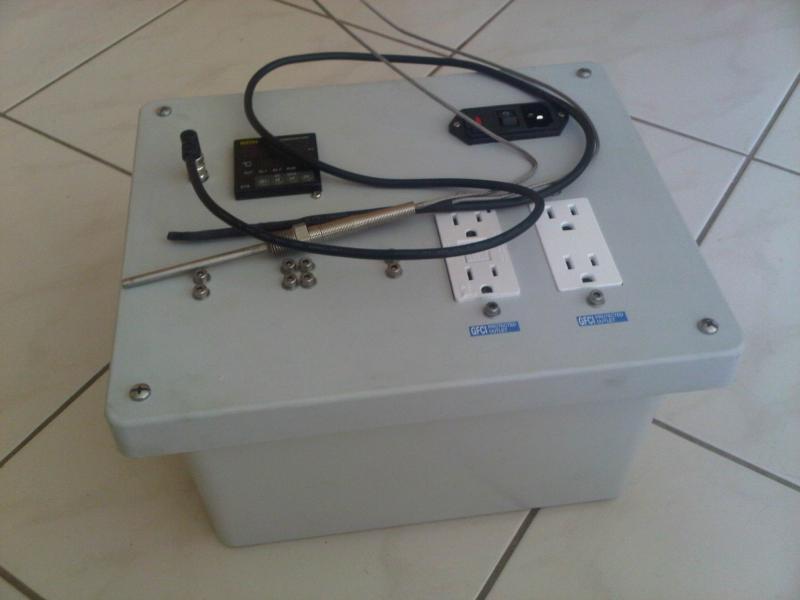
HowardLi
participating member-
Posts
433 -
Joined
-
Last visited
Content Type
Profiles
Forums
Store
Help Articles
Everything posted by HowardLi
-
-
Parts list: Sestos D1S-VR PID controller Panel-mount M8 3-pin female connector eBay Pt100 probe spliced into a M8 3-pin right-angle male plug /w cable Corcom AC input filter /w integrated switch and double fuseholder (currently using 10A fast blow fuses) Omron G3NA-240B DC5-24 solid state relay attached to an old CPU heat sink (with Thermalright Chill Factor III thermal paste) NEMA 5-15R receptacle NEMA 5-15R receptacle (GFCI-protected) Various terminal blocks Various crimp connectors Various screws and bolts Proctor-Silex 1000W electric burner Electra 1150W immersion heater What isn't shown is a 3" round by 3/4" thick piece of cork that the probe sticks into so that it floats on top of the water. I have used both the electric burner and the immersion heater with good success. AC wiring is brown - live, blue - neutral, green - ground per current European standards. Well, the ground wiring is supposed to be striped green/yellow, but I didn't have any handy. The receptacles are wired in such a way that the GFCI receptacle also protects the regular receptacle from earth leakage current. The GFCI unit is always on and can be used for pumps, fans, etc. while the regular unit is the one powered through the relay. Any questions?
-
Sand off the corrosion, all of it, until raw metal is exposed, and make sure any grease or oil is completely washed off. Let air-dry. This will allow the natural protective aluminum oxide layer to re-form. Finish with a coat of shellac (not cut with anything else - needs to be food-safe) over the abraded aluminum. If this still doesn't fix it, find a chunk of zinc and attach it with a screw with a star washer. If you can get a good electrical connection between the zinc and the aluminum, the zinc will act as a sacrificial anode to protect the aluminum. EDIT: The melting point of shellac varies but it's good for at least 75C.
-
Not sure where we're going with this, so I'll just redirect you earlier in the thread: see #476 and later.
-
Thermal soak? The meat is cooked for a long period of time - in fact one of the principles of SV is that the entirety of the food is at a uniform temp. Also, I should note that when I removed the meat from the bath, there was a LOT of juice. Didn't measure it, but I would say the patties were [uncooked] ~5oz and released more than 1/4 cup of juice.
-
Follow-up: I recently calibrated the sensor using boiling water (I figure, as a standard, it's closer to cooking temps than ice water is), and my sensor was under-reading by about 2.3F. Huge deal? Maybe. I'll have to do more to see.
-
It's Friday tomorrow now. Good luck.
-
I've read that meat stops accepting smoke once it gets hot; I suppose this validates that adage, then?
-
I'm not sure I understand your question. Are you asking me/us why we eat it?
-
I did some burgers at 145 F today (~63C). Can anybody explain why they came out totally gray, with no hint of pink?
-
I made this just now. Tastes great, but the acid level might be a bit high for some folks. How do I know? I made this with 3 kg of potatoes (instead of 3 lbs...) by accident, realized my mistake, and doubled the mayo, pickles, and green onion. I left the drizzle the same. I had the eggs at the 1x amount, but I don't think they add too much to the dish. Also I omitted the bacon due to a friend's dietary requirements.
-
You mean go to the washroom...
-
Thanks interesting, thanks, but why "shame on you, Glad" ? None of the products leached BPA or phthalates even if some had them in the materials... Is it not possible that it could leach out? Just because it doesn't happen in testing (with "food substitutes") doesn't mean that it couldn't happen in particular, untested-for situations in real life.
-
On an unrelated note, has anybody checked out this web page? http://www.goodhousekeeping.com/product-testing/reviews-tests/kitchen-cooking/plastic-safety-heat-food-6 Looks like regular zip-top bags might be safe after all... but shame on you, Glad.
-
Pre-freezing the burgers seems like the way to go. But other than the fact that I don't happen to have small blocks of dry ice just lying around in my kitchen, I have some possible concerns about using CO2. My understanding is that it is used commercially to provide extended shelf life for say, chicken, under retail display conditions (not long-term storage). But doesn't CO2 plus water form carbonic acid (it's been a long, long time since my last chemistry class)? And although that might have beneficial bacteriostatic properties, do I really want carbonic acid on my burgers? If I do go the route of adding a gas port to my Minipack chamber vacuum, I'm thinking that I would probably want to use nitrogen, rather than C02 as the filler gas. Nathanm, you've got every appliance known to man -- do you have any thoughts on this issue? I'm pretty sure you wouldn't be able to taste it - it's an extremely weak acid, significantly weaker even than acetic acid, and remember that there will not be a lot of CO2 in the package. Anyway, you're right, nitrogen or argon would be superior to CO2. I just figured dry ice would be easier to get.
-
Put a small block of dry ice into the bag and then let the bag sit upright with most of the zipper closed. Leave a small vent. The CO2 will displace nearly all the oxygen, so once you vacuum (or water-press) the bag, whatever's left will be fairly devoid of O2. EDIT: The CO2 sinks, so if you let the bag fall over or invert it, you will lose your precious inert purge.
-
The only way the drop in water temp could be significant is if you time your cooking based on "duration in water" only, and not by texture. Or, you could claim that the drop in temp _in itself_ has an adverse effect, but I think you'd be on shaky ground. And if you say that the time it takes to boil the water is irrelevant, my guess is that you don't boil pasta too often?
-
The issue with the temperature drop is a moot point; it takes longer to boil more water, so it evens out in the end.
-
And never cook with C4. You can do it as long as your food is sealed. I think it's just the fumes from the burning C4 that are toxic. There's little or no risk of explosion without an actual detonator.
-
Another vote for Chinese cleaver.
-
Molded and Filled Chocolates: Troubleshooting and Techniques
HowardLi replied to a topic in Pastry & Baking
What type of plastic is it? -
Has anybody grilled chicken wings that were SV to 160-165 F? Did anybody experience overdone-ness? Should I hold them at a lower temp (say 145F) for a longer time and them use the tolerance to ensure that the meat doesn't become dry while still remaining safe? Seems logical, right? Also, if I marinade the wings, is it safe to SV them without removing all the marinade? It would be rather convenient to simply take the bag out of the fridge and dunk it into the water.
-
The water and oil will naturally separate, but if the oil does not solidify at room temp, put it in the fridge (or worst case, freezer to scrape off of the ice).
-
This method works great for regularly sliced bacon but I find it makes shoe leather out of the thicker stuff. No way! This is a huge waste - no drippings for use in various applications, such as cornbread and flavoring green beans &etc. I will stick to my old fashioned method which gives me both the bacon and the drippings. Microwave bacon produces perfectly nice drippings. I've used microwaved bacon drippings for years--always have a container of it in my fridge. No different than skillet-collected drippings, frankly. I have a microwave bacon tray that's angled with a trough at one end, which makes it so easy to pour off the collected fat. I don't have a problem with microwaved bacon - I have a couple of the grill plates and also a couple of the gadgety things for cooking bacon. I also have an old Corning grill pan that does a terrific job and is usually my microwave bacon cooker. And it can go into a warm oven to keep the bacon warm, unlike the Nordic Ware bacon tray. My objection was to wrapping it in paper towels. The drippings can't be recovered from paper towels, sadly, they are gone forever. Have you tried simmering the saturated paper towels in water?
-
Knife Sharpening: Where to go in Vancouver?
HowardLi replied to a topic in Western Canada: Cooking & Baking
You could always send them to this guy: http://www.japaneseknifesharpening.com/services.html He's reputable on the knifeforums.

